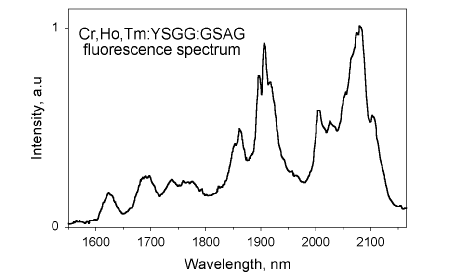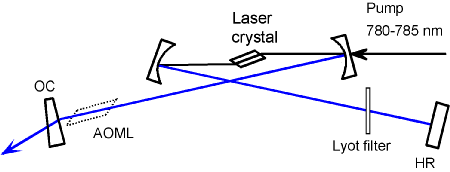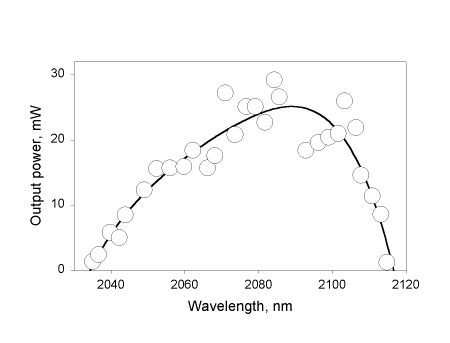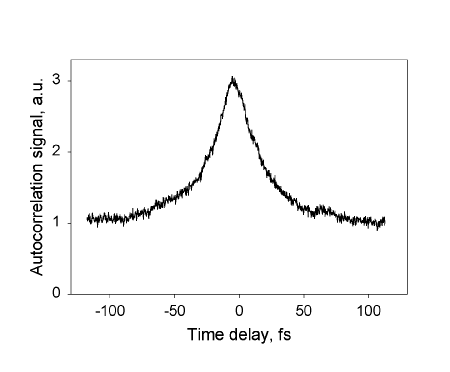
New Diode-Pumped Femtosecond Lasers
E. Sorokin, I.T. Sorokina, A. Unterhuber, S. Naoumov, E. Wintner,
Institut für Allgemeine Elektrotechnik und Elektronik,
TU Wien, A-1040 Vienna, Austria
A.I. Zagumennyi, I.A. Shcherbakov,
General Physics Institute, Russian Academy of Sciences,
Moscow, Russia
V. Carozza, A. Toncelli, M. Tonelli,
Dipartamento di Fizica, University of Pisa,
Pisa, Italy
A. V. Shestakov,
POLUS Science-Technical Company, Moscow, Russia
Diode-pumped tunable (over 80 nm) cw operation achieving 30 mW of output power was demonstrated in a novel mixed garnet crystal Cr,Tm,Ho:YSGG:GSAG at room temperature. A comparison has been made with Cr,Tm,Ho:YAG and Tm,Ho:YLF. We also report the first demonstration of room-temperature continuous-wave laser action at 1.5 µm of Cr4+:YAG directly pumped at 970 nm by a 2 W diode array.
Introduction
Compact all-solid-state tunable and mode-locked crystalline lasers, operating in the vicinity of the 2 µm region, attract a lot of interest for many applications in medicine, remote sensing, and laser radar measurement. The largest vibronic shift in rare-earth-doped active media and correspondingly large tunability range of more than 100 nm was demonstrated in Tm:YAG and Tm:YSGG [1]. The shortest published pulses (35 ps at 70 mW of average output power), generated in the 2 µm-region, have been obtained in actively mode-locked cw Tm:YAG lasers [2]. Tm-based lasers, however, are known to have higher threshold and be less stable in the cw regime as compared to Tm,Ho-systems [3], associated with the combined action of the thermo-lensing effect and a relatively small emission cross-section of Tm3+ ions. In this respect the Tm,Ho-doped crystals are generally more favorable for diode-pumping and cw mode-locking. However, the tunability of Ho ions is characterized by smaller tuning ranges and a more spiky tuning curve since the phonon-broadened fluorescence linewidth of individual Stark transitions is less than the separations of the Stark lines. Although the multiplicity of the Stark levels in the Ho and Tm ions is higher than in other rare-earth ions, their fluorescence spectrum is not smooth, being unfavorable for both tuning and mode-locking. That is why we looked for a suitable host crystal for Tm3+ and Ho3+ ions, allowing smooth and broad tunability, simultaneously allowing for efficient diode-pumping and mode-locking.
A few years ago, a new class of laser-active media has been developed, the crystals of solid solutions of scandium containing aluminum and gallium garnets YSGGxGSAG1-x [4], which we call "mixed garnets". The disordered nature of these crystals results in a strongly inhomogeneous broadening of both the fluorescence line (Fig. 1) and the absorption bands. This allowed in case of Nd-doped GSAG:GSGG garnets to broaden and smoothen the gain spectrum, and decrease the achievable mode-locked pulse duration by an order of magnitude [5,6].

Fig. 1: Fluorescence spectrum of Cr,Tm,Ho:YSGG:GSAG.
We implemented the approach of solid solution crystals towards the development of Tm and Ho-doped active media, and grew high optical quality crystals of yttrium-gadolinium-scandium-gallium-aluminum garnet with the following composition: Cr,Tm,Ho:YSGG0.5GSAG0.5. The crystals were grown by Czochralski technique in a radio-frequency-heated iridium crucible, which was 60 mm in diameter and 60 mm high. The orientation of growth was <110>. The dopant concentrations in the crystal were c1 (Cr3+) = 2x1020 cm-3, c2 (Tm3+) = 4x1020 cm-3, c3 (Ho3+) = 0,5x1020 cm-3. The boule was 140 mm long and 22 mm in diameter. Growth conditions were characterized by a pulling rate of 4 mm/h, a rotation rate of 20 r.p.m., and an atmosphere of nitrogen containing 2 % by volume of oxygen. The crystals were annealed at 1200 ° C for 10 h in the air. The lattice parameter of Cr,Tm,Ho:(GSAG)0.5(YSGG)0.5 is a = 12.4093 Å . The crystal has a density of 5.54 g/cm3. The thermal conductivity of these crystals at a temperature of 300 K is about 5.9 W/(cmK), being slightly less than in Cr:Tm:Ho:YAG and Cr:Tm:Ho:YSAG laser crystals [7], but comparable with that of the crystal components (YSGG and GSAG).
Another alternative for diode pumped broad band IR lasers is the Cr4+:YAG laser, first reported in [8], being a unique laser source, tunable over an attractive wavelength range for many applications of 1.34 – 1.6 µm [9]. Diode-pumping of Cr4+-doped materials, however, remains a challenging task due to difficulties in growing of the crystals with high Cr4+ concentration. The diode-pumped operation of Cr4+:forsterite and Cr4+:Coa2GeO4 reported recently required the ideal beam of a MOPA source [10]. Hence, no results on direct diode-pumping of any Cr4+-doped material with a conventional diode array are known to us at the moment.
Although only Cr4+ ions in tetrahedral sites are responsible for laser action [11], [12], growth of this material generates a large concentration of parasitic Cr4+ and Cr3+ ions in octahedral sites. In this work, the doping levels of Cr2O3 and charge-compensating MgO were optimized to achieve highest concentration of Cr4+ in tetrahedral sites with lowest Cr2O3 level. For the final Cr![]() concentration of ;
1018 cm-3 the starting Cr2O3 concentration was only 2x1019 cm-3. To further increase the Cr
concentration of ;
1018 cm-3 the starting Cr2O3 concentration was only 2x1019 cm-3. To further increase the Cr![]() /Cr
/Cr![]() ratio, we used annealing for 200 hours at 1250 – 1300 °C in oxygen atmosphere. This resulted in a reduced absolute laser threshold at high initial absorption coefficient (;
3 – 3.5 cm-1).
ratio, we used annealing for 200 hours at 1250 – 1300 °C in oxygen atmosphere. This resulted in a reduced absolute laser threshold at high initial absorption coefficient (;
3 – 3.5 cm-1).
Experimental
Cr,Tm,Ho:YSGG:GSAG Lasers
In order to make a fair comparison of different crystals we used equal 2.5 mm thick Brewster-cut samples. For diode pumping the resonator was X-shaped with 20 – 40 cm arm lengths, and two curved (R = 75 mm) mirrors (Fig. 2). For mode-locking experiments the arm lengths were increased to 70 cm to match the fixed frequency of the acousto-optic modulator, and we took R = 100 mm mirrors. Output coupling was 0.6 % – 3 % . The laser was pumped at 782 nm by both, Ti:sapphire (up to 1.4 W) and a diode array (up to 0.9 W), but due to the unoptimized Tm3+ concentration only ; 35 – 50% of pump power was absorbed. Tuning was performed by a 1.5 mm Lyot filter.

Fig. 2: Schematic diagram of a setup for both, diode and Ti:sapphire pumping of Tm,Ho lasers. OC: output coupler. HR : High reflector. AOML: acousto-optic mode-locker.
To characterize the cw performance of the newly developed Cr,Tm,Ho:YSGG:GSAG crystal we also tested other common 2-µm active media as Cr,Tm,Ho:YAG, Cr,Tm,Ho:YSGG, and Tm,Ho:YLF in the same cavity (see Table 1). As expected, Tm,Ho:YLF showed the lowest threshold and the highest efficiency, pumped by either source, but only 20 nm tuning range. In case of Cr,Tm,Ho:YAG lasing was achieved between 2085 and 2117 nm. The tuning curve, however, consisted of distinct lines, which could be identified as Stark lines in the fluorescence spectrum. Finally, Cr,Tm,Ho:YSGG:GSAG allowed to reach the goal of a wide unbroken tunability under both, Ti:sapphire- and diode-pumping (Fig. 3), which along with the good slope efficiency (14.3 %, comparable to Cr,Ho,Tm:YAG) certainly favor the new material.
|
Cr,Tm,Ho:YSGG:GSAG |
Cr,Tm,Ho:YAG |
Tm,Ho:YLF |
|
|
Pumping: |
Ti:Sapphire Diode |
Ti:Sapphire Diode |
Ti:Sapphire Diode |
|
Threshold OC = 0.6 % OC = 3 % |
78 mW 190 mW 280 mW 460 mW |
71 mW 180 mW 180 mW 400 mW |
40 mW 120 mW 65 mW 175 mW |
|
Slope OC = 0,6 % OC = 3 % |
10 % 6,7 % 40 % 14,3 % |
10 % 9 % 42 % 22 % |
23 % 9,7 % 59 % 28,5 % |
Table 1: Cw performance summary at room temperature.

Fig. 3: Tuning curve of the diode-pumped Cr,Tm,Ho:YSGG:GSAG laser.

Fig. 4: Collinear autocorrelation of a modelocked Cr,Tm,Ho:YSGG:GSAG laser. Pulsewidth is 25 ) 2 ps, assuming the Gaussian pulseform.
Modelocking was obtained by means of an acousto-optic modulator and resulted in pulsewidths of 25 ± 3 ps at 100 mW of average output power at 100 MHz repetition rate. The corresponding autocorrelation trace is shown in Fig. 4. The obtained pulse duration agrees with the theoretical prediction [13] for the parameters of our laser, assuming an effective gain bandwidth of 40 nm.
These first mode-locking results are quite promising. The achieved broad tunability along with good efficiency and smooth tuning curve allow to hope for successful passive mode-locking of this crystal and consequently shortening of the pulse duration down into the femtosecond regime (theoretically down to 25 fs). However, analysis and optimization of the cavity dispersion is necessary.
Cr4+:YAG Laser
The basic experimental setup is shown in Fig. 5. The Cr4+:YAG crystal was pumped through the flat dichroic (HR at 1.5 µm, AR at 970 nm) mirror and absorbed over 90% of pump radiation at 6 mm length. A 1.5 W (up to 2 W pulsed) diode was focused into a ; 60 x 100 µm2 spot. The laser was operated in a stable cw regime for the first time. With all mirrors highly reflecting we measured 0.26 % of losses through the mirrors and 1.1 % crystal internal losses. In this configuration, although using two diode arrays the lasing threshold was 1.6 W at room temperature and total output power reached 20 mW. For comparison, Nd:YLF pumping of the same cavity through the curved mirror yielded 0.7 W threshold.

Fig. 5: Experimental setup of a diode pumped Cr4+:YAG laser.
Conclusion
In conclusion, diode- and Ti:sapphire-pumped cw broadly tunable (80 nm) and efficient (16% of slope efficiency) laser action of a Cr,Tm,Ho:YSGG:GSAG laser was obtained at room temperature and compared with other common Tm,Ho-doped crystals. In the mode-locked regime, 25 ps pulses at 100 mW of average output power and 100 MHz repetition rate have been obtained by active modelocking. Preliminary results show a large potential of this laser for mode-locking over the entire tuning range of 80 nm and for obtaining much shorter pulse durations using appropriate passive mode-locking techniques.
In case of the diode-pumped Cr4+:YAG laser, we believe that the reported results show good feasibility of cw lasing by direct pumping with diode arrays at 970 – 980 nm. We are currently optimizing the setup parameters to obtain higher output levels at room temperature.
Acknowledgments
This work was supported by the Austrian National Science Foundation Projects P 10733, P 12756, and the Austrian National Bank Project No. 6727.
References
[1] R.G. Stoneman and L. Esterowitz, Opt. Lett., 15, 486, 1990
[2]
J.E. Pinto et al., L. Esterowitz and G.H. Rosenblatt, Opt. Lett., 17, 731, 1992[3] F. Heine et al., E. Heumann, G. Huber and J. Koetke, OSA Proceedings on Advanced Solid-State Lasers, 15, 403, 1993
[4] E.V. Zharikov, A.I. Zagumennyi, G.B. Lutts, V.A. Smirnov, I.T. Sorokina, I.A. Shcherbakov, Las. Phys. 1, 216, 1991
[5] E. Sorokin, M.H. Ober, I.T. Sorokina, E. Wintner, A.J. Schmidt, A.I. Zagumennyi, G.B. Lutts, E.V. Zharikov, I.A. Shcherbakov, J. Opt. Soc. Am. B. 10, 1436, 1993
[6] M.H. Ober, E. Sorokin, I.T. Sorokina, F. Krausz, E. Wintner, Opt. Lett., 17, 1364, 1992
[7] A.I. Zagumennyi, G.B. Lutts, P.A. Popov, N.N. Sirota, I.A. Shcherbakov, Las. Phys. 3, 1064, 1993
[8] N.B. Angert et al., Sov. J. Quantum Electron., 18, 73, 1988
[9] N.I. Borodin, V.A. Zhitnyuk, A.G. Okhrimchuk, A.V. Shestakov et al., Sov. Phys. Izvestiya, 54, 1500, 1990
[10] J.M. Evans, V. Petricevic, A.B. Bykov, A. Delgado, R.R. Altano et al., Opt. Lett., 22, 1171, 1997
[11] S. Kueck et al., OSA Proc. on Adv. Solid- State Lasers, 10, 92, 1991
[12] A.G. Okhrimchuk and A.V. Shestakov, Opt. Materials, 3, 1, 1994
[13] D.J. Kuizenga and A.E. Siegman, IEEE JQE, QE-6, 694, 1970
Project Information
Project Manager
Univ. Prof. Dr. Ernst Wintner
Institut für Allgemeine Elektrotechnik und Elektronik, TU Wien
Project Group
|
Last Name |
First Name |
Status |
Remarks |
|
Carozza |
Valentina |
diploma |
|
|
Naoumov |
Sergej |
student |
|
|
Sorokin |
Evgeni |
postdoc |
|
|
Sorokina |
Irina |
postdoc |
|
|
Unterhuber |
Angelika |
student |
|
|
Wintner |
Ernst |
university professor |
Books and Contributions to Books
Publications in Reviewed Journals
Presentations
Patents
Cooperations